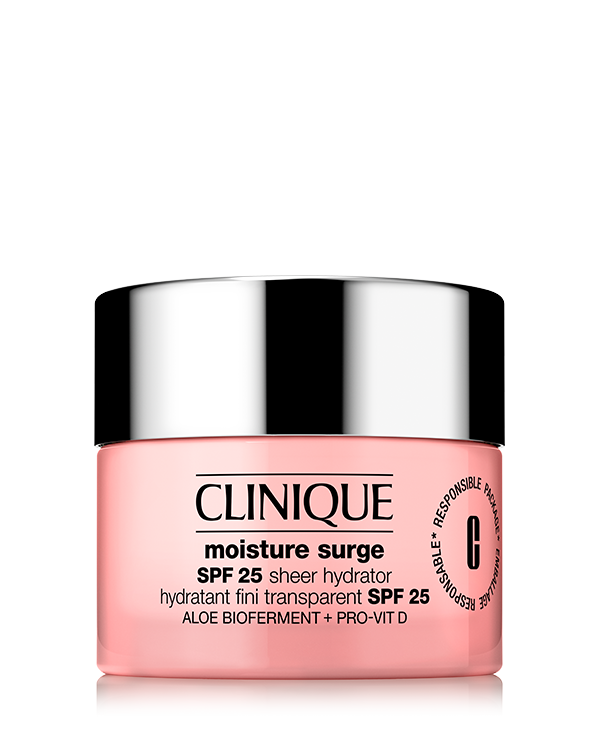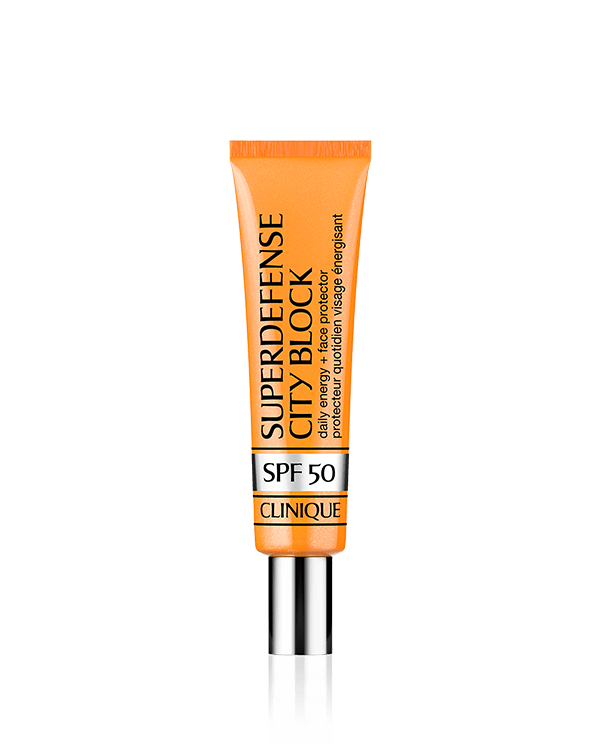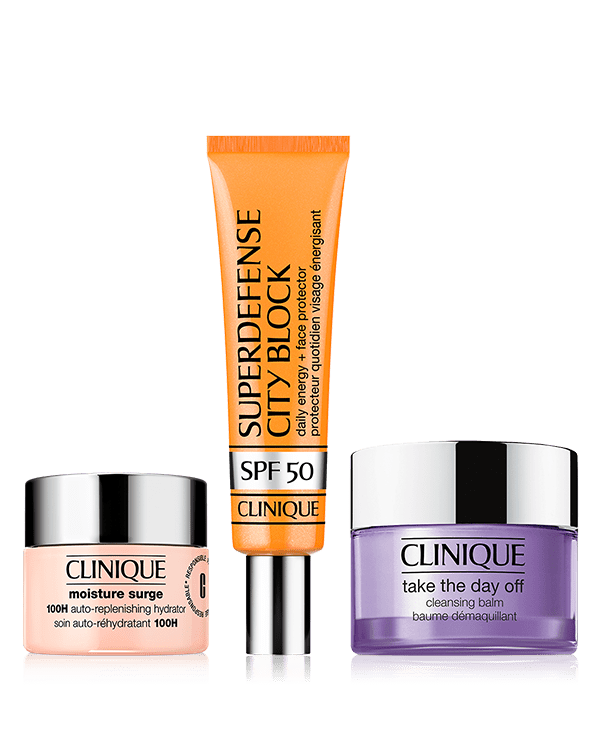
SPF 101
SPF 101
If there’s one skincare step that’s going to make a difference to your skin in the long run, it’s sunscreen. The closest you’ll get to a “miracle” product, an effective daily SPF is a gamechanger for healthy, happy skin. If you’re serious about taking care of your skin, daily sunscreen should be a non-negotiable in your routine, every single day.
As a brand rooted in dermatological science, Clinique has always championed daily SPF. In fact, we were the first premium skincare brand to launch a dedicated suncare line, creating gentle, dermatologist-guided formulas to help protect all skins from harmful UV rays. Today, we continue to combine UV protection with advanced skincare ingredients in allergy-tested, fragrance-free SPF formulas for every skin type.
As important as daily sunscreen is, we know there are still lots of question marks surrounding sunscreen and SPF – from how much sun cream you need to use, to which SPF level is best. We’ve got you covered with our expert guide to all things SPF, featuring tips, tricks and advice from our global band of experts, including dermatologists and our own SVP of Global Product Development, Janet Pardo. Keep reading to learn all about sunscreen and discover the best suncare-meets-skincare formula for you.



Though we often use SPF as a generic term for sunscreen, sunblock or sun cream, SPF actually stands for ‘sun protection factor’, and the number tells you the level of protection, meaning how long it would take for the UV radiation to burn your skin when using the product, versus without any protection. For example, if you correctly apply a layer of SPF 50, this should theoretically shield your skin 50x longer than wearing no SPF at all. However, it’s important that you reapply at least every two hours to maintain this level of protection. For reference, SPF 15 will block 93% of UVB rays, SPF 30 blocks 96.7% and SPF 50 blocks 98% of UVB rays. Sunscreen, on the other hand, refers to the formula containing SPF, which is what you actually apply to your skin.
SPF glossary.
UVA: There are three types of ultraviolet (UV) rays: UVA, UVB and UVC, though almost no UVC reaches the earth’s surface. UVA rays are present all year round, can penetrate cloud and windows, and have a longer wavelength, meaning they can work their way down to the middle layers of your skin. These are the UV rays commonly associated with skin ageing, and they cause skin to tan as they trigger melanin production. UVA rays can also burn the skin and increase the risk of some skin cancers.
UVB: UVB rays have a shorter wavelength and higher energy levels, meaning they damage the outermost layers of the skin. These are the UV rays that cause sunburn and are commonly associated with most skin cancers.
Broad-spectrum: A broad-spectrum sunscreen provides both UVA and UVB protection. If your SPF does not specify broad-spectrum, it may provide UVB protection only.
Chemical sunscreen: Chemical sunscreen ingredients such as oxybenzone and homosalate work by absorbing the sun’s rays. Chemical sunscreens are typically sheer, lightweight formulas that are less likely to leave a white cast on the skin.
Physical or mineral sunscreen: Mineral or physical sunscreens such as zinc oxide and titanium oxide sit on top of the skin to block UV rays from penetrating the skin’s surface. Generally, mineral sunscreens are recommended for sensitive and blemish-prone skin types, as they are often non-comedogenic, however given the nature of the UV filters, they can be slightly thicker in texture and some can leave a white cast.



What level SPF should you use?
There’s no ‘right’ SPF level for everyone, as this depends on your unique skin tone, skincare routine and lifestyle factors. If you have fair skin and hair, or if you have freckles and moles, most experts recommend wearing a minimum of factor 30 or 50 every day, all year round. If your skin rarely burns, or tans more easily, daily protection is still a must, however factor 15-30 should be sufficient for daily use. Beyond skin tone, it’s important to wear a high level of SPF (ideally SPF 50+) if you are spending a lot of time outside or if you’re using active ingredients like retinoid/retinol or chemical exfoliators, which can make your skin more sensitive to UV light and sun damage. If in doubt, a daily moisturiser with SPF 30, such as our new Clinique Smart Clinical Repair™ Winkle Correcting Cream SPF 30, is a good place to start.
How much SPF should you use?
Probably more than you think. Dermatologists often recommend using a dessert spoon-sized amount all over the face, neck and chest, or the length of two fingers. “Make sure to apply sunscreen behind your ears and all the way down your neck,” explains Dr. Pompa. If applying to your body, a good rule of thumb is to use 1 oz., or the size of a shot glass, for each application.
Everyone should wear SPF daily. “No matter what your skin tone is, how much time you spend outdoors, or what time of year it is, everyone needs to protect their skin from UV rays every day,” says Miami-based dermatologist Dr. Adriane Pompa. “UV rays penetrate clouds and windows, so even 10 or 15 minutes of sun exposure each day can add up to lines and wrinkles over time.”
This is where incidental exposure comes into the equation. “Incidental sun exposure is any brief exposure to the sun that might seem inconsequential, but any amount of exposure to the sun can cause damage, no matter how seemingly brief or mild, so it's important to always wear SPF for maximum protection,” explains Janet Pardo, Clinique’s SVP of Global Product Development. A great everyday SPF? Moisture Surge™ SPF 25 Sheer Hydrator.



How does sun affect your skin?
Beyond sunburn and a higher risk of skin cancer, sun and UV damage can also accelerate the breakdown of skin’s collagen support structure, leading to the appearance of dry lines, deeper wrinkles and more visible pores over time. “Sun protection is critical to an anti-ageing routine, since up to around 90% of the visible ageing signs are a result of sun damage.* In order to help prevent or slow down those signs, wearing SPF and protecting your skin from UV rays is critical,” explains Janet Pardo.
UV damage and other environmental factors can also trigger overproduction of melanin leading to dull-looking skin and exacerbating existing dark spots or leading to new ones. Sun damage can accumulate over time, so if you’re noticing dehydration, uneven skin tone, fine lines and wrinkles today, this could be the result of historic sun damage. Try our Clinical Reality skin analysis tool for a closer look at your own skin, including invisible sun damage.
*Source: Skin Cancer Facts & Statistics – The Skin Cancer Foundation.
When to apply sunscreen.
Apply sunscreen every morning as the final step in your skincare routine, then give it some time before heading outside. “Always apply sunscreen before you leave the house,” Dr. Pompa recommends. “It can take up to 15 minutes for the sun-shielding ingredients to bond with your skin and become effective.”
Reapplication is key to effective sun protection. When exposed to direct sunlight, you should reapply SPF every two hours to achieve maximum protection. Even if you’ve chosen a waterproof SPF formula, this will only be water-resistant for a limited time, so always reapply after sweating, swimming or drying off.
How to layer skincare + SPF.
It’s easy to layer skincare and SPF with our advanced, skincare-powered sunscreens. When it comes to skincare layering in general, the rule is to work from lightest to heaviest formula, always ending with an effective SPF to protect your skin. For example, apply your skincare in this order: cleanser, toner/essence/Clarifying Lotion, serum, eye cream, moisturiser, SPF. If you’re using an SPF moisturiser, such as Moisture Surge™ SPF 25 Sheer Hydrator, then you can use that as the final 2-in-1 step, but remember to reapply throughout the day.
If you’re wondering whether to apply primer before or after sunscreen, we recommend applying primer after sunscreen, before foundation.
What is the best SPF for oily skin and blemish-prone skin?
Finding a great SPF for oily skin can be tricky, as some sunscreens can feel heavy, thick and greasy on the skin. Today, there are lots of SPF options for oily skin, without that traditional sunscreen feel. The trick is to look out for oil-free formulas with physical sunscreen ingredients, rather than chemical sunscreen, and avoid anything fragranced as this can cause blemishes and breakouts. Our best sunscreen for oily skin or blemish-prone skin is the SPF 50 Mineral Sunscreen Fluid For Face, an ultra-lightweight, oil-free, 100% mineral sunscreen. It’s also suitable for sensitive skin.



What is the best SPF for dry skin?
If you have dry or dry combination skin, a moisturiser with SPF is a good solution. Safe for all skin types, including sensitive skin, our Moisture Surge™ SPF 25 Sheer Hydrator is a light, creamy moisturiser which combines lasting hydration with sheer sun protection – and no white cast. With a weightless yet nourishing cream texture, it’s infused with hyaluronic acid, aloe vera bioferment and provitamin D to lock in moisture for deep, all-day hydration.
Which SPF is best for ageing skin?
Any daily SPF could be considered an anti-ageing step, as it helps to protect skin from harmful UV rays, which can accelerate signs of ageing. For a more targeted formula, try NEW Clinique Smart Clinical Repair™ SPF 30 Wrinkle Correcting Cream, a lightweight, dermatologist-tested SPF moisturiser which combines SPF 30 protection with powerful actives including hyaluronic acid, peptides and provitamin D. “There is a growing interest in preventative skincare, as well as SPF products,” explains Janet Pardo. “While there are many anti-ageing products on the market, we have created a unique formula with this cream that offers those benefits of daily repair, while also preventing further damage with SPF protection.”
Which SPF is best for sensitive skin?
If you're looking for the best sunscreen for sensitive skin, try a mineral SPF formula. Though mineral sunscreens like zinc oxide and titanium oxide can leave a white cast, they are thought to be less irritating on skin, making them the best option for sensitive skin types. We also recommend using an SPF 30 or higher, as any sun damage will only exacerbate sensitive skin symptoms. Our SPF 50 Mineral Sunscreen Fluid ticks both boxes.
Which tinted sunscreen is best?
A tinted sunscreen combines sun protection with complexion-perfecting pigments to help even out your skin tone, conceal any imperfections and counteract redness. Our best tinted sunscreen? Superdefense™ City Block SPF 50 Daily Energy + Face Protector works to protect, hydrate and perfect skin with sheer tint. This lightweight, oil-free tinted sunscreen is formulated with a blend of chemical and mineral sunscreens, alongside nourishing hyaluronic acid and wheat extract. You can wear it on its own for a radiant no-makeup look, or wear under makeup to prep, prime and protect skin.
For a little more coverage, try Moisture Surge™ Sheertint Hydrator SPF 25, a tinted hydrator with SPF 25. It’s packed with powerful hydrating ingredients like hyaluronic acid and activated aloe vera water to keep skin plump and dewy for 12 hours, while a sheer tint perfects and smooths the skin. For higher protection.
Our dermatologist-educated experts, at your service.
Educated in partnership with dermatologists, our team of Clinical Consultants are here to help you achieve your skin goals. Schedule your complimentary Clinical Consultation today for personalised skincare advice, built on dermatological science.
Shop Clinique suncreen and SPF moisturiser:


